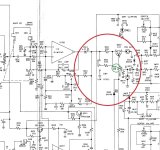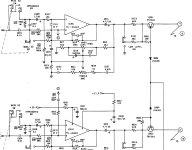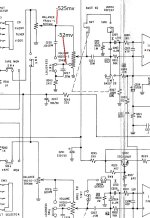morning-
i wonder if i any of you guys have an opinion on something ive tried resolving many times without any success, and this is a common problem with these units
The low level switch clicks when depressed
now i have taken them out, stripped them down and cleaned them, swapped them with others, ive even tried replacing the 2 muting FETS and the resistors in the circuit, but to no end, so i just wondered if you had any thoughts on it
Ive been all over the muting circuit and low level switch, and can find no evidence of noise with the scope, other than the scope changes very slightly(jumps) when the switch is depressed.
Its more anyoying than anything because i cant find it and have this on 90% of the units ive had though my hands, and now i want to find it once and for all.
cheers
paul.
i wonder if i any of you guys have an opinion on something ive tried resolving many times without any success, and this is a common problem with these units
The low level switch clicks when depressed
now i have taken them out, stripped them down and cleaned them, swapped them with others, ive even tried replacing the 2 muting FETS and the resistors in the circuit, but to no end, so i just wondered if you had any thoughts on it
Ive been all over the muting circuit and low level switch, and can find no evidence of noise with the scope, other than the scope changes very slightly(jumps) when the switch is depressed.
Its more anyoying than anything because i cant find it and have this on 90% of the units ive had though my hands, and now i want to find it once and for all.
cheers
paul.
Attachments
i wonder if i any of you guys have an opinion on something ive tried resolving many times without any success, and this is a common problem with these units
The low level switch clicks when depressed
I wonder if it could be a design fault. You get a click when there is a sudden abrupt change in DC conditions and how much of a change in DC conditions depends on the voltage here:
If there was say 15 volts here then you could see a jump of around 10mv in DC level at the input which doesn't sound much until you realise that jump is applied directly to power amp input.
With no signal applies try measuring the DC voltage here and then operate the level switch and see if there is a change.
You need to look at the DC shift as that is what causes clicks. It is the sudden step change in voltage. For the level switch you have the DC voltage on R517/518 applied via a 10meg and thorough the gate/source and gate/drain channel of the FET both of which will behave like a forward based diode. So 15 volts on those resistors (if that's what it is) passes through the 10meg and feeds the 6k8 on the input of the FET and also into the 10k bass control. That generates a small DC voltage on the 6k8. When the 680 ohm is switched to ground that voltage suddenly changes and you hear that as a click.
You have the obvious change at the drain as you mute it, that is 35mv down to 2mv,is that the noise. Could that be suppressed with a small cap?I wonder if it could be a design fault. You get a click when there is a sudden abrupt change in DC conditions and how much of a change in DC conditions depends on the voltage here:
View attachment 1303170
If there was say 15 volts here then you could see a jump of around 10mv in DC level at the input which doesn't sound much until you realise that jump is applied directly to power amp input.
With no signal applies try measuring the DC voltage here and then operate the level switch and see if there is a change.
View attachment 1303171
35mv down to 2mv,is that the noise.
Its not so much noise as a single step change in the DC conditions where the voltage suddenly shifts from one value to another. The difference in the mute circuits is considerable because now the gate is turned on via the 10meg permanently and 0V is enough to turn the FET on with the only place to go from would be to turn it off by making the gate negative. The diodes are now fitted the other way around and can actively pull the gate down while in your version it relies on leakage in the diodes (and there is enough leakage to do this even though its only nano amps) to pull the gate down.
So yes, it may well be to improve this aspect. I see the FET is different as well... similar but maybe with more suitable characteristics for this.
so, being the person i am, i cant let it rest so ive started digging a bit more further back.
am i right in saying i shouldnt have these DC voltages here, as there is nothing present on the other channel and this could be the cause of the issue?
this is with a CD signal input playing through
am i right in saying i shouldnt have these DC voltages here, as there is nothing present on the other channel and this could be the cause of the issue?
this is with a CD signal input playing through
Attachments
Have you tried with only speaker at a time connected to see if it really is silent on the other channel?
Ideally there should be zero volts at that point but you also need to look at where it might come from.
The balance control should be able to 100% remove that voltage if turned to one end on the relevant channel and the volume control should be able to remove it completely on minimum volume. This is moving to a different area than the original low level switch problem and it is possible you have two issues, both of which may be design problems. You need to carefully investigate one at a time beginning with the low level switch problem.
If you short the FET's out and also remove the two 10meg resistors then I would say the level switch should be silent.
Ideally there should be zero volts at that point but you also need to look at where it might come from.
The balance control should be able to 100% remove that voltage if turned to one end on the relevant channel and the volume control should be able to remove it completely on minimum volume. This is moving to a different area than the original low level switch problem and it is possible you have two issues, both of which may be design problems. You need to carefully investigate one at a time beginning with the low level switch problem.
If you short the FET's out and also remove the two 10meg resistors then I would say the level switch should be silent.
It's def only one channel that the voltage issue exists, and that voltage does dissappear when the balance is swung over. I already shorted out the FET's and the noise remains, it's also slight apparent on the loudness, but only one channel, and the tape input switch also clicks, but none of the others do
For the level switch you must also isolate the 10meg resistors as they are providing a slight current into the 6k8 resistor and bass pot. If you measure the voltage I arrowed on R517/518 you can approximately calculate the voltage you might expect to see on the FET drain and source.I already shorted out the FET's and the noise remains,
If it was 15 volts then very approximately I think you would have around 30 millivolts with the switch in one position and about 1 millivolt when the 680 ohm is switched in.
That makes up one problem area around the low level switch. Forget everything else for now and see why that one switch makes a click. Everything in front of that area of the circuit may or may not click but if it does that is another issue not related to the level switch.
You have two separate things going on here.
The voltage is around 17v. With switch out it's 32mv and 2mv depressed so you were close
So you have in reality 17 volts (less the diode and FET drop which we'll ignore) across 21k +6k8. That gives you the voltages you measure.
So that step change in voltage is a 'non fixable' characteristic unless you could modify the circuit in some way (like the other version you posted). A cap won't work because it is all audio on that line an you can not reduce the rise and fall times of the transient change. Reducing the current through the 10meg is the answer and that is what the other version does in a round about way.
Any dc over the switch can only come from the fet
It is coming through the FET, or rather the current that generates this voltage is. The FET's G/S and G/D channels behave very much like a diode when forward biased and so it just completes the circuit for continuity and passes the small current the 10 meg allows. And that is enough...
so quriosity has got the better of me here, so ive dug my own personal one out of its box buried in the loft and plugged it in
no noise from any switch,so i guess the only thing here to start with is a comparison
not entirly sure why i didnt do this ages ago! (prob because it was a pain to get to)mind you i still may not find the answer, but its worth a bit of scrutiny
no noise from any switch,so i guess the only thing here to start with is a comparison
not entirly sure why i didnt do this ages ago! (prob because it was a pain to get to)mind you i still may not find the answer, but its worth a bit of scrutiny
so replacing C309 and C310 cured the noise from all the switches apart from the low level, so thats a start and at least im only looking at one issue nowOnly ohms law but I guessed the voltage at 15 volts and did not include the diode volt drop or the FET's G/S and G/D drop which is around 0.5 volts. I rounded the tone network bass section (which is the direct path to ground) to 21k.
So you have in reality 17 volts (less the diode and FET drop which we'll ignore) across 21k +6k8. That gives you the voltages you measure.
So that step change in voltage is a 'non fixable' characteristic unless you could modify the circuit in some way (like the other version you posted). A cap won't work because it is all audio on that line an you can not reduce the rise and fall times of the transient change. Reducing the current through the 10meg is the answer and that is what the other version does in a round about way.
It is coming through the FET, or rather the current that generates this voltage is. The FET's G/S and G/D channels behave very much like a diode when forward biased and so it just completes the circuit for continuity and passes the small current the 10 meg allows. And that is enough...
So I guess my question ultimately has to be, why do 10% of amps not have the problem, there has to be an answer
You need to begin then by actually comparing the circuits for real to make sure no production mods have been introduced. See if the FET's are the same. Compare the voltages that actually control the FET's from the mute circuit.
Well done. So you now have just that original issue to deal with.so replacing C309 and C310 cured the noise from all the switches apart from the low level, so thats a start and at least im only looking at one issue now
- Home
- Amplifiers
- Solid State
- NAD 3130 low level switch clicking when depressed/released


